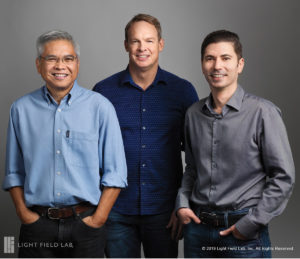Light Field Lab Raises $28 Million For Huge Holographic Displays
 San Jose, California-based Light Field Lab will use the money to scale its display technology from prototype to product. The aim is to create holographic objects that appear to be three dimensional and float in space without head-mounted gear such as augmented reality or virtual reality goggles.
San Jose, California-based Light Field Lab will use the money to scale its display technology from prototype to product. The aim is to create holographic objects that appear to be three dimensional and float in space without head-mounted gear such as augmented reality or virtual reality goggles.
Jon Karafin, CEO of Light Field Lab, told me in an interview in November that he wants to bring real-world holographic experiences to life with up to hundreds of gigapixels of resolution, including modular video walls for live event and large-scale installations.
“The ultimate goal is to enable the things that we all think of in science fiction as the hologram,” Karafin said. “There’s a lot of things out there, but you know, they say that flying cars and holograms are the two things that science fiction hasn’t yet quite delivered. And we’re going to at least get that started.”
Light Field Lab’s technology re-creates what optical physics calls a “real image” for off-screen projected objects by generating a massive number of viewing angles that correctly change with the point of view and location just like in the real world. This is accomplished with a directly emissive, modular, and flat-panel display surface coupled with a complex series of waveguides that modulate the dense field of collimated light rays. With this implementation, a viewer sees around objects when moving in any direction such that motion parallax is maintained, reflections and refractions behave correctly, and the eyes freely focus on the items formed in mid-air. The result is that the brain says, “this is real,” without having any physical objects. In other words, Light Field Lab creates real holograms with no headgear.
The company plans to take smaller holographic image components and assemble them into very large images. Back in November, the company showed me two-inch, see-through holographic image that the company can produce as its basic core building block. There’s no head-tracking, no motion sickness, and no latency in the display. It takes place within a six-inch by four-inch space, or the core building block.
Jon Karafin said “We want to make sure that the way we roll our technologies out is starting with the really big thing, using large-scale, high-value entertainment experiences, showing something that is transformational that nobody has ever seen before.”
In addition to holographic displays, Light Field Lab’s technology includes the hardware and software platform required for content distribution.
“Verizon’s new 5G network features the higher bandwidth, low latency, and speed/throughput to deliver next generation content,” said Kristina Serafim, investment director at Verizon Ventures, in a statement. “Light Field Lab’s innovative solution will help build the 5G future for Verizon’s consumer, business, network, and media customers.”
See the full story here: https://uploadvr.com/light-field-lab-raises-28/
Pages
- About Philip Lelyveld
- Mark and Addie Lelyveld Biographies
- Presentations and articles
- Tufts Alumni Bio